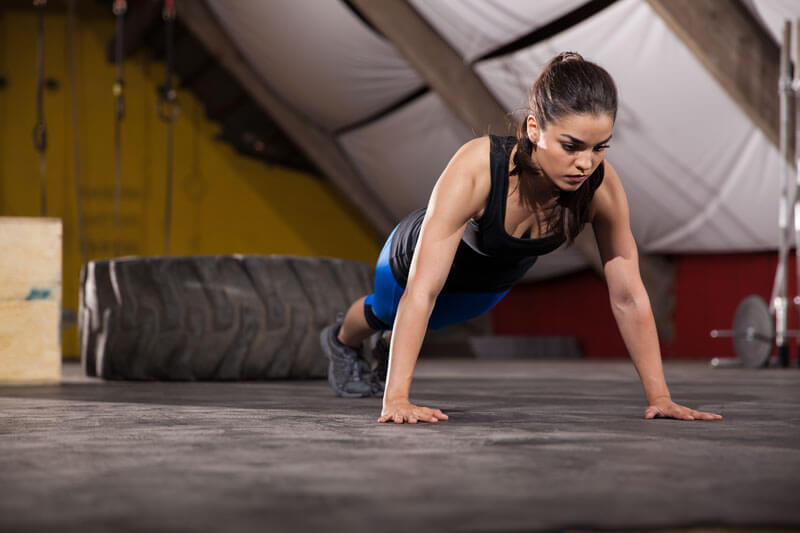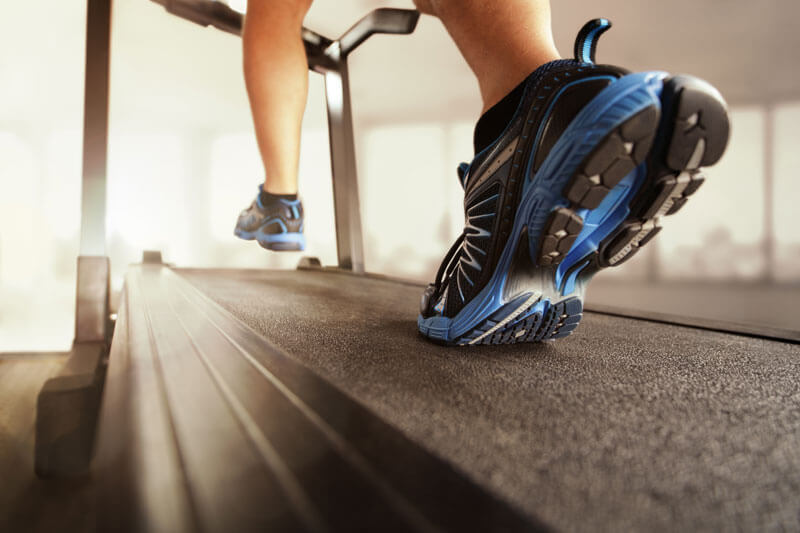Today’s question: Can you get in shape just by doing cardio?
The answer is … yes, it has been done.
Is it recommended? Absolutely not.
Many contemporary urban legends or “myths” surround our popular understanding of what makes for a good cardiovascular workout. But many of these myths are misinformed, if not dangerous.
If you’re trying to get fit and cut down on fat, it’s important to know the science instead of the hearsay.
The American Heart Association recommends that healthy adults between ages 18 and 65 get 150 minutes of moderate-intensity aerobic activity each week. Between 30-minute sessions of walking (yes, this will do), riding a bike or gardening around the house, it’s easy to add this exercise. To meet this recommendation, you need only break a sweat and feel your heart beating a little faster than normal. You should still be able to maintain a conversation during this type of exercise.
This post is going to outline the 7 best ways to obtain the most from your cardio workouts. It will also address the 7 most common myths surrounding the modern cardio routine – and why they’re false.
#1 All Cardio Isn’t Good
False Myth: To lose weight, focus on cardio over strength training.
Mixing weights and cardio is the fastest, healthiest way to burn fat and calories. Plus, an entire cardio exercise plan is boring.
“Strength training builds lean muscle mass, which both increases your metabolism and decreases fat,” says celebrity trainer Elizabeth Hendrix Burwell, co-owner of High Performance Gym. “So the more muscle you build, the more calories you burn on a day-to-day basis.”
This is because muscle is metabolically active and stimulates your metabolism. For each pound of muscle you add to your body, you will burn up to an additional 50 calories a day.
For ladies concerned with staying lean and avoiding bulky muscles, have no fear. The female body doesn’t produce testosterone in quantities (⅓ that of men) sufficient to build large muscles. Plus, to look “jacked” you’d have to spend years doing a heavy duty rotation of weights.
For a toned, tight appearance to the body, muscle mass is a must. The healthiest and most envious fit bodies all have a firm, strong layer of good muscle under the skin.
Muscles only respond to overload. Lifting lighter weights is not the solution to staying feminine – it’s a waste of time. Keep a strenuous weight training workout or two (or more) in your weekly routine to start looking tighter, leaner and slimmer.

Pro Tip: Double up on strength training as cardio training. A recent study from the American Council on Exercise reveals that kettlebell exercises burn up to 20 calories a minute – equivalent of running at a 6-minute mile pace!
Another study found that those who cycled for 20 minutes in the middle of a resistance workout saw a greater metabolism impact post-exercise than those who kept their workouts segmented.
Maximize your weekly weight-loss benefits by incorporating up to four non-consecutive days a week of resistance-based exercise. Kettlebells, weight lifting and TRX (suspension training) are great choices.
#2 Use the Machines Wisely
False Myth: Focus upon burning at least 500 calories during a cardio session.
Yes, this is a good estimate. But avoid slogging away on the treadmill in pursuit of the magic number that says it’s time to quit. Machines can only roughly estimate your metabolic rate, so chasing the 500 calories-burned mark is not a sustainable means to weight loss.
Better to ignore those red digits on the console and focus your energy solely upon your intensity.
Here’s why: A recent study named the elliptical trainer the least accurate when it comes to calorie counting, with most machines overestimating the burn by 42%, says SHAPE fitness editor-at-large, Jay Cardiello.
Leaning forward on the stair stepper can reduce your total calorie burn by up to 50%. And treadmills are shown to reduce your total calorie burn between 2%-10%.
Overall, most people overestimate the calories burned during workouts. Know that this is true and hack your workout by remembering the hard science of it all.
First, research proves it takes between 40-50 minutes of sustained cardio before the body starts burning fat.
Second, use a heart rate monitor to maintain the necessary energy levels to get and stay fit. Aim to exercise between 75-85% of your maximum heart rate. In other words, if you’re using a scale of 1-10 to gauge your exertion, try to stay between 8 or 9 for the higher intensity intervals.

#3 Add Interval Training
False Myth: I can use a treadmill or an elliptical machine for all my cardio.
The human body adapts exceedingly well and quickly to the stresses of exercise. Once you’re consistently exercising for 30 minutes at a time, add some interval training to your routine. Mixing in a few short bursts of intensity to your workout will make them better but not necessarily longer.
Working harder in shorter bursts is proven to burn more fat and calories than “easier” types of cardio, like treadmills and ellipticals. After a HIIT session, your body will expend greater quantities of calories throughout the day in order to repair itself. Plus, your body receives a 24 hour-long metabolism boost afterward from operating at these high levels.
The Journal of Applied Physiology published research measuring the effects of interval training on women in their 20s. Women of varying fitness levels rode stationary bikes in intervals alternating between hard and easy efforts. These 4-minute bursts of 90% effort were followed by 2 minutes of rest. The 2 week training cycle involved 10 sets in each session, training every other day. By the end, the amount of fat burned during 1 hour of continuous moderate cycling increased by 36% and their cardiovascular fitness increased by 13%.
This suggests that it only takes 1 or 2 interval sessions per week to see real benefits. Slowly incorporating intervals into an existing routine is an amazing way to elevate the quality of your workouts in a gradual, natural way with real advantages.
#4 Alternate Exercises
False Myth: Training for a race will help you lose weight.
Your body, like your life, your nutrition, your relationships – requires a fine degree of balance. If you’re only doing one type of training you could be hurting yourself and obstructing your fitness goals.
For example, many choose to train for a long distance run like a 5K or marathon as a way to get in shape.
But distance running is not going to return great results. The sustained, repetitive training needed to help you go the distance and cross the finish line actually will only make you more efficient at conserving energy (calories).
As it comes to anticipate long distances, the body starts burning fewer calories every time you run, says Jon-Erik Kawamoto, former competitive runner, certified strength coach and personal trainer.
Given the commonly noted increase in appetite – and the increased caloric consumption – many runners end up gaining weight before a race.
Kawamoto recommends supplementing a running program with at least 3 resistance training workouts a week. These should focus on key, opposing muscle groups, such as back and chest. This is crucial for not only improving joint mobility and function, but also strength. It also burns additional calories.
He also suggests switching one day of running for a cross-training cardio workout to help prevent injury and further challenge your cardiovascular system.
False Myth: All high-intensity training is the fastest way to go.
Doing all high-intensity, maxed-out cardio training leads to injury and overtraining fatigue in many. If you’re the hitting high-intensity routine every day you go, give it a break. Or at least mix up your routine.
“The higher the intensity of your workout, the more total calories you will burn,” says Marta Montenegro, professor of exercise and sports sciences at Florida International University and certified trainer. This burn lasts up to 24 hours after your last rep or step and studies show you’ll melt fat faster because it is a prominent fuel source for high-intensity activity.
The body does burn fat as fuel during lower-intensity workouts; the “fat-burning zone” is about 65% of your max. However, you should focus on overall calorie expenditure for weight loss – not the fuel source – says Montenegro.
Balance your routine to consistently burn the most calories. Professor Montenegro suggests alternating high alow-intensityity workouts to allow the body time to recover and develop consistently.
For example, do high-intensity intervals Mondays and Thursdays, low- and moderate-intensity workouts Wednesdays and Saturdays, and then mix in strength training and yoga Tuesdays and Fridays.
#5 Separate Heavy Weights and Intense Cardio
False Myth: You should start with cardio or strength training.
It doesn’t matter one bit the order in which you exercise. However, it does matter how much energy you have to give your workouts.
“If you’re hitting the treadmill for an intense cardio session and then plan to hit the weights afterward, you’ll have little left in your tank to make your resistance training count,” says Lindsay Vastola, certified trainer and founder of Body Project Fitness and Lifestyle.
If you’re going to go hard on weights or high-intensity cardio one day, don’t expect to have much left afterwards. It’s best to alternate the days that you hammer your hardest exercise routines. This way you can give it your all on those days and burn more calories.
That said, for those hitting the weights heavy and trying to add mass, cardio can have big advantages. Guys, cardio can help your body repair muscle damage faster because it increases blood flow. This means your body builds muscle up quicker and removes waste products, such as lactic acid, quicker.

Pro Tip: Do a cardio session after a rugged leg day. This will dramatically decrease the soreness in the days to follow. For help on the upper body, hit the rowing machine.
#6 Balance Your Cardio – or Lose Muscle
False Myth: Lots of cardio is the most efficient way to lose body fat.
Excessive cardio will strip away muscle as it burns fat. This is definitely not the efficient method to get rid of unwanted flab. Once you lose muscle, your body becomes less efficient at burning fat.
If you do too much cardio, your body enters a catabolic state and begins to eat its own muscle. If you’re not a distance runner, any more than 60-70 minutes a day is counterproductive. And if you’re not eating enough calories and protein to maintain the caloric expenditure, you’ll start to suffer.
#7 You Need to Eat Before Cardio Sessions
False Myth: An empty stomach helps you burn more fat during a cardio workout.
The combination of large muscles in the legs require a combination of carbs and fats for energy. When you run or bike without the proper sustenance, your body will go after carb and fat fragments in your bloodstream and muscle stores – not the fat in the cells around your body.
On an empty stomach, you may become hyperglycemic and low on hydration. Your intensity will drop as a result and you stop short of the 40-50 minutes of necessary cardio that research show us is vital to burning fat.
Your ratios of macros (fat, carbs, proteins) are important. The key to losing body fat and becoming lean is controlling your insulin levels. If we consume excess calories or excessive amounts of high glycemic carbohydrates at once, the body’s blood sugar rise. When this happens, the pancreas releases the hormone insulin to lower blood sugar levels.
When this happens, the body holds onto stored body fat.
The way to get and stay lean is to eat a proper balance of fats, proteins and complex carbs while avoiding sugars and other high glycemic carbohydrates.
It’s recommended you eat at least 90 minutes before a workout to allow food to digest and receive all the nutritional benefits. At least 2 cups of water are recommended between eating and working out.
The Final Push
Cardio workouts are best done in a sustainable, balanced fashion. If you’ve come to think that skipping meals, over-fatiguing muscles and overlooking variety in your exercise is a good thing – think again. When you’re serious about reducing body fat and staying strong and slim, remember to add some weights and variety to the routine. Interval training provides every fitness enthusiast with the ability to achieve more from each workout without adding extra minutes. Remember that weights and high-intensity exercise are best done on separate days. With these tips in mind, you’re 100% ready to make your cardio routine the best it’s ever been!


